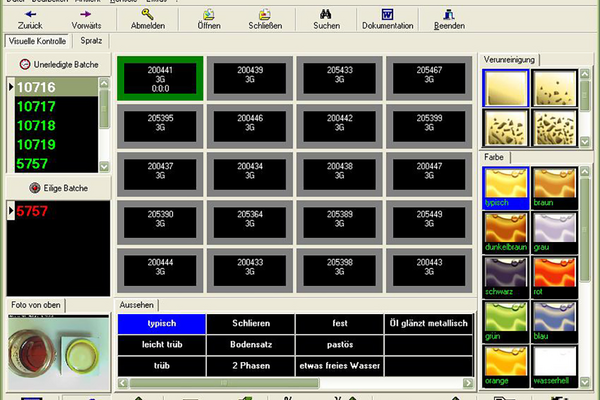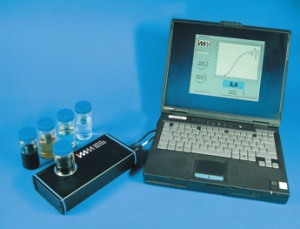Visual assessment of oil samples
Year of publication: 2004
Hundreds of oil samples arrive at the OELCHECK laboratory every day for analysis. Before they undergo the individual tests in the mostly automated analyses, they are examined by a human. This is because the smell and appearance of the oil often already provide interesting information. The change in oil color, particulate contamination and any turbidity caused by water play a very special role in the evaluation of the sample.
As the sample bottles are unpacked, they are grouped into the 20-sample trays according to origin. Thus, engine oils go with engine oils and hydraulic oils are grouped next to hydraulic oils. The filled sample racks are stored with their transparent OELCHECK bottles for at least 15 minutes in the "upside down" position, i.e. standing on the lid. Any foreign substances in the oil then sink to the white inner surface of the lid and are easier to detect after the bottle has been turned over and opened.
The subsequent first diagnostic view falls on the white inner surface of the lid seal immediately after the sample vessel is quickly turned over and opened. A backlit magnifying glass with 2x to 5x optics reveals particles larger than 25 µm; with the unaided eye, only particles larger than about 40 µm can be distinguished.
The inside of the lid and the well illuminated opened sample bottle are then photographed together with a camera and assigned to the sample number. These two photographs can be viewed by customers at lab.report and, if necessary, printed out. After photography, an initial assessment of the appearance of the oil sample and any sediment present in the lid is made by comparative estimation. The photos of the oil samples show how different the images can be.
As an additional analysis there is the odor control. The OELCHECK lab technician opens the sample bottle, fans over the oil, and determines if there is a typical or atypical odor. Atypical odors can be pungent, acidic or musty, for example. But even if the oil was initially drawn into a shampoo bottle, the olfactory sense may provide evidence of an atypical soap odor. The result is documented via pre-written statements on a touch screen under the respective sample number. A noticeable odor is detected in about 2% of all samples.

Contaminants
Visual assessment can be used to classify the type of contamination in advance. The information as to whether particles are sealing materials, corrosion residues or dust particles, for example, can provide valuable information for the final evaluation.
Such contaminants can be easily identified, especially with magnification. The findings are classified on the screen. For this purpose, the OELCHECK experts in the laboratory use a proven scheme.
In addition, the optical impression of the sample is examined from the outside, and the questions as to whether there are streaks in the oil, whether the sample is turbid, whether there are two phases or whether water is separating or sediment is present are recorded by simply tapping on the corresponding symbols on a "touchscreen".
Color
In principle, the color of an oil is not an absolute quality characteristic. After all, almost any desired shade can be produced with the smallest quantities (less than 1 liter of pre-dissolved dye per 20,000 liters of oil) of the corresponding coloring agent. From pink to bilious green - almost anything is possible. Depending on the intended use, the consumer also expects a certain color shade. Golden yellow for transmission and hydraulic oils, red for ATFs, oils for medical equipment or food processing machinery should be as light as possible. Oils in air filters, on the other hand, are often colored blue.
In the case of an uncolored oil, the coloration depends on the origin, i.e. the well, the degree of refining and the intensity of bleaching of the base oil. However, due to the addition of additives, which in higher concentrations can look up to black, even water-light base oils often become considerably darker.
Nevertheless, the change in color of an oil filling can also provide important information about aging, e.g. oxidation, or about any impurities in an oil. Or quite simply: if the color of a sample deviates from that of the previous sample in the trend, there may be incorrect filling or overheating.
For certain oils, the assignment of a color number is done by a laboratory technician. The color impressions must be basically comparable, i.e. what is light for one laboratory technician may not be evaluated as dark by the other. The oil is classified with the foils of a color chart according to ASTM or DIN ISO, compared and classified into one of the eight color numbers. The color intensity is marked as "color" according to DIN ISO 2049. For support, dyed plastic filter templates are compared with the oil to be analyzed, decanted into a 15 mm thick cuvette. If the color impression between a filter and the oil in the cuvette appears to match, the oil is assigned the corresponding color number by the observer. However, this method of classification depends on the subjective impressions of the observer and often also on the surrounding light conditions.
In order to obtain a clear and comparable color number quickly and without having to decant the oil into a cuvette, OELCHECK is breaking new ground with the WaveCheck 300.
The color number measuring instrument was specially developed for determining the color numbers of oils. In close cooperation between the Institut für Mikrotechnik Mainz GmbH (IMM) and OELCHECK, the instrument was designed for the typical geometry of used oil analysis sample bottles with a standard diameter of 40±1 mm. The sample bottle is placed in the WaveCheck as it is delivered. After approx. 5 s, the color number can be read off or transferred to the database. The blank value for the empty plastic bottle is taken into account in the determination. It is no longer necessary to decant the oil into a cuvette or to clean or dispose of the cuvettes. Time and costs are reduced accordingly. The color number is determined with reproducible accuracy in steps of 0.5 according to DIN ISO 2049.
Crackle Test
A so-called "crackle test" is also part of the initial visual inspection. This test often detects water even if the oil does not look suspicious at first glance. In this determination, after the sample has been shaken vigorously with the pipette, a small drop of oil (only 0.2 ml) is splashed onto a stainless steel plate at a temperature of approx. 160 °C. The oil is then sprayed onto the plate. If the sprayed oil contains more than approx. 0.1% water, the same happens as with hot oil in a kitchen pan into which a drop of water falls. The oil bubbles briefly and the water vapor escapes with a crackling, hissing sound. This, in conjunction with the small, precisely defined amount of oil, produces typical bubbles up to stronger "splashes", which the trained eye of the OELCHECK laboratory technician can assign according to appearance and distribution in a 4-level table corresponding to water values and enter into the database via a touch screen. But this visual water determination is not the only way. Nevertheless, the subjective impression when "crackling" often provides additional information for our experienced tribologists besides the determination of the water with the FT-IR or according to the Karl Fischer method.
But it is not always water when the oil throws bubbles. Slightly boiling impurities such as fuel or solvents also cause bubbles. However, these have a different appearance than water vapor bubbles. These do not escape with a hissing sound, but splash off the hotplate with a rattling noise.
To recognize the difference at first go, however, requires some experience of the trained eye of an OELCHECK laboratory technician, who has already observed thousands of oil drops during the crackle test.




